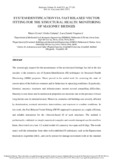JavaScript is disabled for your browser. Some features of this site may not work without it.
| dc.contributor.author | Civera, Marco | |
| dc.contributor.author | Calamai, Giulia | |
| dc.contributor.author | Zanotti Fragonara, Luca | |
| dc.date.accessioned | 2021-02-10T15:49:15Z | |
| dc.date.available | 2021-02-10T15:49:15Z | |
| dc.date.issued | 2021-01-23 | |
| dc.identifier.citation | Civera M, Calamai G, Zanotti Fragonara L. (2021) System identification via fast relaxed vector fitting for the structural health monitoring of masonry bridges. Structures, Volume 30, April 2021, pp. 277-293 | en_UK |
| dc.identifier.issn | 2352-0124 | |
| dc.identifier.uri | https://doi.org/10.1016/j.istruc.2020.12.073 | |
| dc.identifier.uri | https://dspace.lib.cranfield.ac.uk/handle/1826/16331 | |
| dc.description.abstract | The increasingly request for the maintenance of the architectural heritage has led in the last decades to the extensive use of System Identification (SI) techniques for Structural Health Monitoring (SHM) purposes. These proved to be useful tools for assessing the state of conservation of the built environment and its behaviour in operating conditions. In particular, historical masonry structures and infrastructures present several compelling difficulties. Masonry is non-linear and its mechanical properties are uncertain due to the presence of local irregularities and its internal texture. Moreover, centuries-old buildings are severely affected by deterioration, eventual restoration interventions, and exposure to weather conditions. In this work, the Fast Relaxed Vector Fitting (FRVF) approach is proposed as a rapid, efficient, and reliable instrument for the vibration-based SI of such structures. The method is preliminarily validated on simple numerical examples and a multi-damaged cantilevered box beam, then tested on a true 1:2 scaled model of a masonry two-span arch bridge. The results match well the estimations from other well-established SI techniques, such as the Eigensystem Realization Algorithm (ERA), and can be utilised for damage assessment (with all the standard advantages and limitations of modal-based outlier detection). Stabilisation diagrams and frequency-damping plots are also proposed for FRVF. | en_UK |
| dc.language.iso | en | en_UK |
| dc.publisher | Elsevier | en_UK |
| dc.rights | Attribution-NonCommercial-NoDerivatives 4.0 International | * |
| dc.rights.uri | http://creativecommons.org/licenses/by-nc-nd/4.0/ | * |
| dc.subject | Masonry bridges | en_UK |
| dc.subject | Bridge monitoring | en_UK |
| dc.subject | Architectural heritage | en_UK |
| dc.subject | Structural health monitoring | en_UK |
| dc.subject | System identification | en_UK |
| dc.subject | Experimental modal analysis | en_UK |
| dc.subject | Non-destructive testing | en_UK |
| dc.subject | Stabilization diagram | en_UK |
| dc.title | System identification via fast relaxed vector fitting for the structural health monitoring of masonry bridges | en_UK |
| dc.type | Article | en_UK |
Files in this item
The following license files are associated with this item:
This item appears in the following Collection(s)
-
Staff publications (SATM) [4439]

